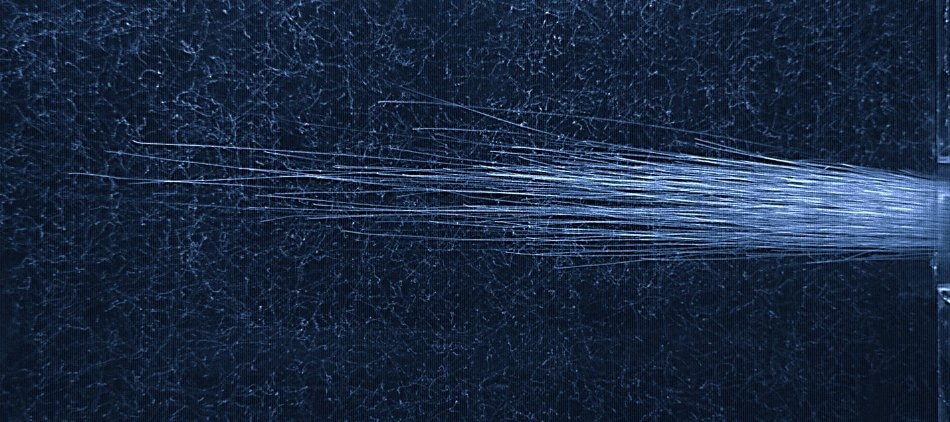Mar 16 2017
Nanostructured surfaces have manifold applications. Among others they are used to selectively increase aborption of light. You can find them everywhere, where light harvesting is the key point, e.g. in photovoltaics. But also in laser proton acceleration this approach attracts a lot of attention as nanostructured targets hold the promise to significantly increase maximum proton energies and proton numbers at a given laser energy. As for any other new technology, a high efficiency is a key for a potential future use. Scientists at the Max-Born-Institute (MBI) in Berlin have now investigated, under which conditions the use of nanostructures in laser ion acceleration is beneficial.
 Fig. 1: Laser accelerated ions, becoming visible in a Wilson chamber. (Credit: Max Born Institute)
Fig. 1: Laser accelerated ions, becoming visible in a Wilson chamber. (Credit: Max Born Institute)
If an ultrashort laser pulse (˜30 fs, >1 J) is focused onto a solid target foil, such that relativistic intensities (>10¹⁸ W/cm²)) are reached, matter is transformed immediately into a plasma by field ionization. Electrons are accelerated to relativistic energies in the laser field. While fastest electrons can leave the target, those with less (but still relativistic) energy are trapped in the coulomb field of the (now) positively charged target and start to oscillate in this field. They form a dynamic sheath that, together with the target surface, generates an electric field of several megavolts per micrometer, in which positive ions (e. g. protons and carbon ions from the surface contamination layer) experience extreme acceleration. This process is called target normal sheath acceleration (TNSA). Fig. 1 shows an image of such a proton bunch.
The idea behind using nanostructured surfaces is now straight forward: Nanostructures increase laser absorption, i. e. more and more energetic electrons are generated which, in turn, can accelerate protons to higher energies.
But there are also alternatives for optimizing the TNSA mechanism - particularly important is the optimization of the plasma gradient, i. e. the density profile of the target. The laser intensities applied are so huge, that ionization of the target does not only happen when the peak of the laser pulse interacts with the target, but already starts during the rising edge of the pulse. The pre-ionized plasma expands, the plasma density decreases. The plasma gradient is therefore essentially determined by the exact temporal pulse structure.
The team of Dr. Matthias Schnuerer from Max-Born-Institute in Berlin has investigated, under which conditions the use of nanostructured targets is beneficial. For this purpose, the physicists have laser structured their targets in-situ. This method of generation of periodic surface structures via a laser (LIPSS) is particularly simple and in principle allows the development of a high repetition rate target system. In a first step, the target surface is nanostructured by applying about 20 strongly attenuated laser pulses. A representative scanning electron microscopy image of such a surface is shown in fig. 2. The structural parameters are similar to those that maximize laser absorption. Structural analysis and simulations show that these structures possess nearly optimal parameters for maximum laser absorption. In the following step, a single fully amplified pulse is focused onto this nanostructured area. Dr. Andrea Luebcke and her co-workers have investigated the influence of those nanostructures on the proton spectrum for different laser intensities. They chose a laser contrast that is optimal at highest intensities. First of all, the scientists could show that nanostructures remain functional even at highest intensities at the present contrast conditions in the sense that they increase the laser absorption as evident from an increase of Kα yield (see. Fig. 2a). For relatively low intensities, nanostructures significantly enhance both the conversion efficiency and proton energies. For example, at 5x10¹⁷ W/cm² the maximum proton energies were increased by a factor of four, the conversion efficiency from laser to proton energy was even enhanced by two orders of magnitude. However, at highest laser intensities with optimal laser plasma parameters no significant benefits from the nanostructures for ion acceleration were measured (Fig. 2b,c).
The researchers speculate about fundamental limitations in the energy transfer processes. The scientists were, however, not fully surprised by these results: As in many optimization problems, there are different paths to the optimum and combining them usually does not lead to an even better result. So far, these experiments performed at extreme conditions cannot be theoretically simulated in every respect. It is therefore the merit of this work to have clarified under which conditions the use of nanostructures is beneficial and in which direction new theoretical investigations can be initiiated.